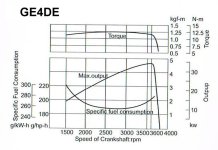TSO
Elite Member
Everything seems to have been answered....
And just a point to consider with HST and that tractor:
The engine is powering the PTO shaft, implement pump, secondary pump for steering (if applicable), flywheel/belt accessories, and finally the internal HST pump. With a gear transmission, you have all of the above except the HST pump. This is why HST is rated for less HP than the gear model equivalent... The engine powers motion thru the internal pump, not direct linkage. Though I suspect that the rating, if measured at the PTO, would be closer in HP rating if both tractors were stationary and in neutral, than they would be while under load and moving... As the HST system draws power.
People say that lugging a diesel engine is not harmful, though I try not to do it too often personally.
And just a point to consider with HST and that tractor:
The engine is powering the PTO shaft, implement pump, secondary pump for steering (if applicable), flywheel/belt accessories, and finally the internal HST pump. With a gear transmission, you have all of the above except the HST pump. This is why HST is rated for less HP than the gear model equivalent... The engine powers motion thru the internal pump, not direct linkage. Though I suspect that the rating, if measured at the PTO, would be closer in HP rating if both tractors were stationary and in neutral, than they would be while under load and moving... As the HST system draws power.
People say that lugging a diesel engine is not harmful, though I try not to do it too often personally.
